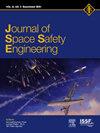考虑交会轨迹的非合作目标激光雷达导航策略
IF 1.7
Q3 ENGINEERING, AEROSPACE
引用次数: 0
摘要
空间碎片的严重危害日益引起人们的重视,许多国家都在积极研究空间碎片主动清除技术。ADR任务中最重要的挑战之一是需要一种高度精确、强大的导航技术来与非合作目标对接。本文提出了一种基于激光雷达的导航系统,特别是一种对现实环境中可能出现的点云异常值具有鲁棒性的点云处理架构。本文以H2A火箭上部为例,对ADR目标进行了研究。提出的方法解决了ADR任务特有的技术问题,例如目标镜面的点云损失和激光雷达的视场(FOV)限制。在实际硬件上进行的动态和静态测量测试结果表明,该方法在近距离操作下具有稳定的估计能力。本文章由计算机程序翻译,如有差异,请以英文原文为准。
LiDAR-Based navigation strategies for a non-cooperative target considering rendezvous trajectory
The grave danger posed by space debris is attracting increasing attention, and many countries are actively researching active debris removal (ADR). One of the most important challenges to an ADR mission is the need for a highly accurate, robust navigation technology for docking with non-cooperative targets. This paper proposes a LiDAR-based navigation system, in particular a point cloud processing architecture that is robust against point cloud outliers that may occur in real environments. This study selected the upper stage of an H2A rocket as an example for ADR target. The proposed method addresses technical issues specific to ADR missions, such as point cloud loss at the target’s mirror surface and LiDAR’s Field of View (FOV) limitations. The results of dynamic and static measurement testing using actual hardware showed that the proposed method is capable of stable estimation in close proximity operation.
求助全文
通过发布文献求助,成功后即可免费获取论文全文。
去求助
来源期刊

Journal of Space Safety Engineering
Engineering-Safety, Risk, Reliability and Quality
CiteScore
2.50
自引率
0.00%
发文量
80
 求助内容:
求助内容: 应助结果提醒方式:
应助结果提醒方式:


